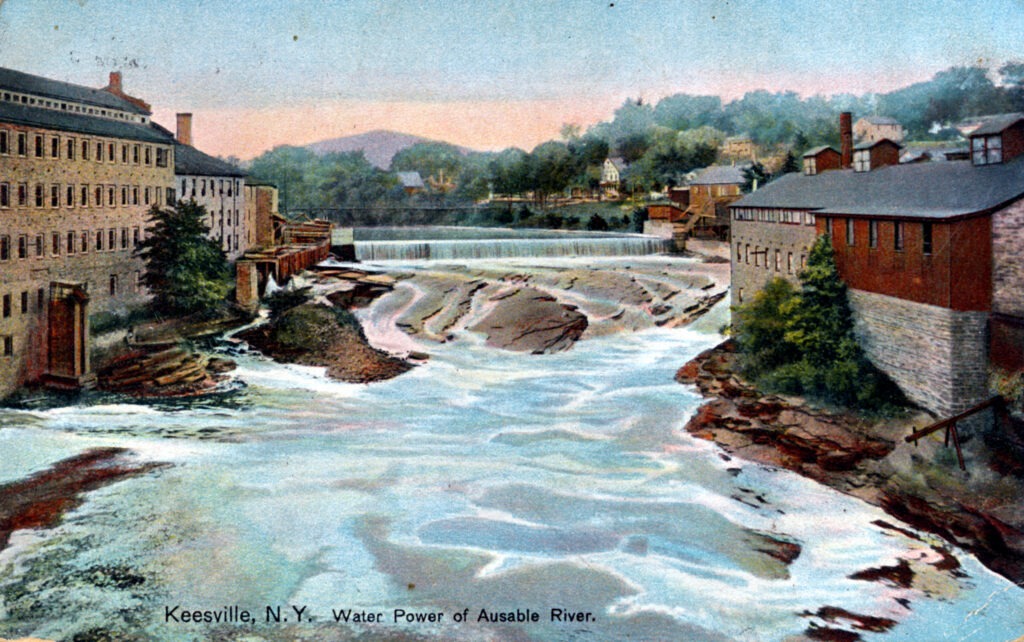Moving Keeseville Forward
Welcome to the New York Forward Grant site for the hamlet of Keeseville. The towns of Chesterfield and AuSable have come together to apply for state grant money through the New York Forward Grant process. The goal is to develop a more desirable living & working community that showcases the unique and character defining recreational & historic aspects of the area.
Take a look at the proposed district where the grant money, if awarded, will be applied by clicking HERE.
We hope you enjoy learning more about the program through the information provided below. If you have any further questions, please feel free to contact either Tim Bresett, Town of AuSable Supervisor or Clayton Barber, Town of Chesterfield Supervisor.
Thank you,
Diana Zais, Chair
NY Forward Grant Committee
Hamlet of Keeseville


New York’s downtowns are the heart and soul of our regions, and Keeseville is no different.
Downtown Keeseville is both a reflection of our past and a catalyst for future growth and revitalization. It is a center for commerce, culture, diversity, entrepreneurship, ideas and entertainment.
Governor Hochul launched NY Forward in 2022 with the overarching goal of revitalizing downtowns and reinvigorating local and regional communities by creating a critical mass of vibrant downtown destinations in each region. NY Forward diverges in several aspects to reach and serve the unique needs and characteristics of the State’s smaller and rural communities.
The following overview of NY Forward will help the community of Keeseville understand our revitalization goals in partnership with the state.
What is NY Forward?
NY Forward supports a more equitable downtown recovery for New York’s smaller and rural communities, with a focus on hamlets and villages.
These downtowns often have a distinctive feel from larger, metropolitan urban centers with unique, easy-to-recognize characteristics. Potential NY Forward communities are those former railroad, canal, coal and mill towns that lost the industry around which their town grew – we often think of these as crossroads or bedroom towns, small business districts along corridors that connect major employment centers and magnet cities in their region.
These communities provide neighborhood scale, local goods and services with iconic boutiques and mom and pop shops that enrich the unique character of that community. With bones built for a vibrant downtown, these communities, through NY Forward, will attract more businesses, residents, and visitors. A healthy regional economy relies on a critical mass of vibrant downtowns of various sizes, character, history, needs, and challenges. NY Forward completes that picture.
Applicants must submit a vision for the downtown and a slate of developable projects to achieve that vision. REDCs (Regional Economic Development Committees) review the application and nominate winners. This process reflects a “plan-then-act” methodology, similar to NY’s Downtown Revitalization Initiative (DRI).
NY Forward allows up to three awards per region – either two $4.5 million awards or one $4.5 million award and two $2.25 million awards.
NY Forward was not designed to fund one large, expensive project. Rather, NY Forward applicants should develop a full suite of synergistic projects that may include one or two substantial anchor projects supplemented by a variety of smaller supportive projects.
NY Forward funds will be used to provide technical assistance directly to communities throughout each phase of the program, from pre-application to implementation, as necessary. By submitting an Intent to Apply form, communities will have access to targeted capacity-building and consultants who can provide guidance on application development.
This one-on-one technical assistance will have ripple effects beyond NY Forward, strengthening their ability to pursue and implement other funding opportunities.
The Process

| Community Selection & Funding | Community Characteristics | Potential Projects |
| $10M in each region – either 2 $4.5M awards or 1 award of $4.5M and 2 awards of $2.25M each | Smaller, walkable, less dense geographical area with amenities that serve the immediate local community | Smaller projects focused on more building renovation and redevelopment and activation of upper-story (ex: housing, additional commercial) rather than new construction |
| Professional, contracted support will provide interested applicants with capacity building webinars and technical assistance. This will begin during pre-application; the cost will not be assessed from the community awards. | More vehicle dependent; patrons mainly arrive by car. Community center that’s service-oriented. Small-town charm – with heritage, antiques, cottage, agriculture and other niche-based tourism. | Adaptive reuse. Projects that deal with vacancy rather than creation of new space. Projects that elevate specific cultural qualities that enhance feeling of small-town charm. |
| REDCs nominate communities. | Vehicle dependent with limited public transportation potential. Residential, or rural agricultural-centric development Low-density: building height, units, acres, etc., tight commercial strip. 2-4 story buildings with opportunities for upper story housing | Application must demonstrate $3-$5M in multiple synergistic projects. Final project award funding cannot be used for one sole project. Tight commercial activity area with opportunity to enhance cultural heritage through signage of historic markers. |
Committee Members
- Diana Zais, Committee Chair | Vice President, Polar Caves Park
- Adam Bailey | Adk Program Manager, Northern Forest Center
- Sawyer Bailey | Executive Director, AdkAction
- Clayton Barber | Supervisor, Town of Chesterfield
- Tim Bresett | Supervisor, Town of AuSable
- Jessica DesLauries | Associate Planner, Essex County Office of Community Resources
- Kelly Frady | Vice President of Marketing + Operations, Coldwell Banker Whitbeck
- Hannah Grall | Project Manager, AdkAction
- Robyn Pray | Director, Keeseville Free Library
- Andy Prescott | President, Town of Chesterfield Planning Board | Vice President, Adirondack Architectural Heritage
- Beth Stevens | Owner, The Stone Mill
- Erin Tobin | Executive Director, Adirondack Architectural Heritage


